9.5 Lagoon exploitation
9.5.1 Aquaculture and capture fisheries
The contribution of lagoon capture fisheries to fish production in Mediterranean coast is minimum and meaningless, as the presence of fisheries and aquaculture activities in coastal lagoons is generally poor, except in South-Atlantic lagoons with Mediterranean influence, where the linkage to aquaculture allowed improves the sustainability of these lagoons. The development of aquaculture in the latter lagoons mainly contributed to the flooding of these areas, which has favoured the creation and maintenance of wetlands.
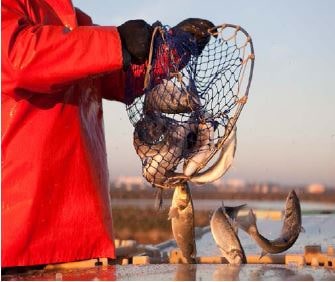
Fishing in Bay of Cadiz, photo ©Ctaqua, 2011.
Fishing gear
Several types of fishing gear are used in Spanish Mediterranean coastal lagoons, and can be distinguished into three groups:
• Fixed traditional gear such as "Pantene" is used in the Ebro delta and other fixed gear are like labyrinths that will drive the fish into a central lagoon as Encanizadas used in the Albufera of Valencia. These types of fishing gear are not much used today, and their use is almost exclusively for recreational activities. Another traditional gear but not fixed is the "ganguil” in the Albufera of Valencia.
• Other types of small traditional fishing gear include networks like traps, trammel nets, or encircling nets used in ponds, canals or small areas to accumulate the fish.
• Longlines are only used in the deepest areas of all lagoons, but are mainly used in the Mar Menor (Valero Palmero, 1972).
Most of the current fishing activities in Spanish lagoons are carried out without the help of boats, which were more common when the lagoons were deeper and had more fishing activities. Therefore, except for Mar Menor, where there is a small fleet of smaller gear, and the Albufera of Valencia, where there are usually no motor boats, in the other lagoons only very small boats are present.
Currently, in the Albufera of Valencia there is an ordinance regulating the register of ships of the Albufera lagoon.
Employment and institutions
The number of jobs linked to the exploitation of aquatic resources in the Mediterranean coastal lagoons is a highly complicated exercise due the scarcity of activity, which influences the lack of statistics data.
An important fact to keep in mind is that the coastal lagoons analysed are located in five different regions or autonomous regions. Aspects related to the management of these lagoons are placed under the responsibility of five different regional governments.
The main area with employment associated is Ebro delta, where the work force is usually linked with fishing, and the number of people directly related with fisheries in coastal lagoons since 1985 are 36 (Generalitat de Catalunya, 2014). Aquaculture employment is still carried out as a complement of fishing, and few in number.
Nevertheless, it is true that time ago when the activity was greater, there were cooperatives that organized and sold the catch, such as the Cofradia of El Palmar in the Albufera of Valencia or the Cofradia of San Carlos de la Rapita in the Ebro delta.
The level of association linked directly with fisheries in lagoons a long time ago was high, and although a number of these organizations maintain their links with the fisheries world in the lagoons, it is minimal at present.
South Atlantic area
The employment generated in South Atlantic lagoons is linked to the aquaculture activity or maintenance of the salt marshes and Esteros. There are 200 jobs linked to the development of aquaculture, and specifically around 80–90 with extensive aquaculture (artisanal fisheries) in this area (Junta de Andalucia, 2010). On the subject of fisheries work force, there are 252 shell fishing (on foot) licences in the Bay of Cadiz and there are other important fisheries groups that working in areas closeby. In addition, in the Bay of Cadiz, there is an important fishing force: the recreational marine fisheries. The Regional Agriculture and Fisheries Authority regulates this activity and normalizes the issuance of licences of recreational marine fisheries.
Aquaculture and capture fishery management
The management of coastal fisheries and aquaculture in Spain depends in most cases on a Regional Government that has competence in activities such as agriculture and fishing.
However, responsibility for environmental protection is often associated to other different authorities such as the Environment Ministry, and this situation means that, although there is a strong control over the protection of these areas, there is little follow up on the catches of aquatic resources, mainly because these are activities of little importance.
Therefore, the most common situation is that the regional government with responsibility for fishery catch has all the information available for capture fisheries, shellfish harvest and aquaculture, while the regional government with responsibility for the Environment only has information in the environmental field.
Fish production
Fish production in the lagoons has dropped significantly over the last 20-30 years to very low levels. The production in the lagoons of the south-Atlantic area is mainly linked to extensive aquaculture, while the production of lagoons (225.45 tonnes in 2010) in the Spanish Levant is entirely from seasonal wild catch (Ministerio de Agricultura, Alimentacion y Medio Ambiente,
2010).
The major species in almost all the lagoons are primarily marine and brackish, with some presence of freshwater species, especially in lagoons as the Ebro delta, where freshwater inputs are higher.
The main species are gilthead bream, seabass, grey mullet, eels and species of freshwater carp and fartet (Aphanius iberus).
The three species with the highest percentage of production in Spanish lagoons are the grey mullets, seabream and seabass, followed by eel and carp. According to statistics analysed by the various ministries of fisheries in the different Spanish regions, it could be extracted that these five species represent over 80 percent of production.
The following tables and figures show production of capture fisheries in different Mediterranean Spanish coastal lagoons. As shown in the table as in the graph, the main species captured in the Mediterranean lagoons are eel, seabream, seabass and grey mullet. It is important to note also the catches of elvers in some lagoons like the Albufera of Valencia, the Ebro delta and the Albufera de Mallorca.
Table III: Fish production in Mediterranean lagoons (tonnes) main species (1980–2010). Source: Ministry of Agriculture and Fisheries in Regional Governments of of Murcia, Valencia, Catalonia and Balearic Island, 2010
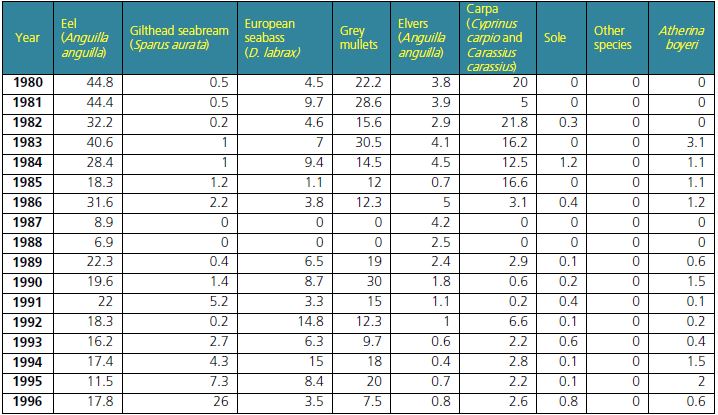
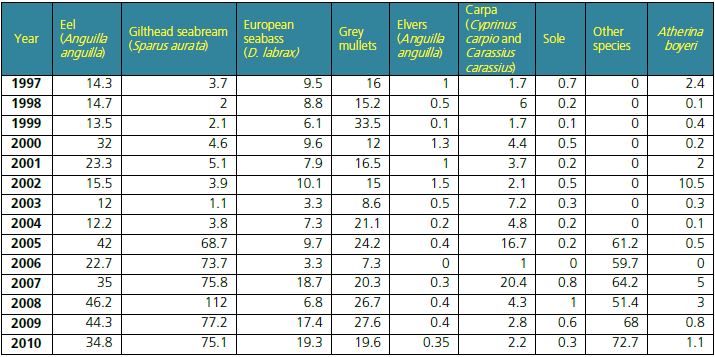
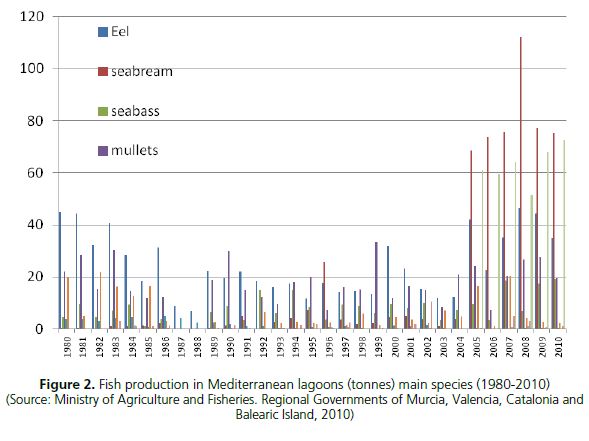
Figure 2. Fish production in Mediterranean lagoons (tonnes) main species (1980-2010)
(Source: Ministry of Agriculture and Fisheries. Regional Governments of Murcia, Valencia, Catalonia and Balearic Island, 2010)
The production from capture fisheries in the lagoons located in the South Atlantic area of Spain is important to emphasize the volume of captures and maintenance over time.
Table IV: Fish production in South Atlantic lagoons (tonnes) main species (1987–2010) (Source: Andalusia Regional Government. Ministry of Agriculture and Fisheries)
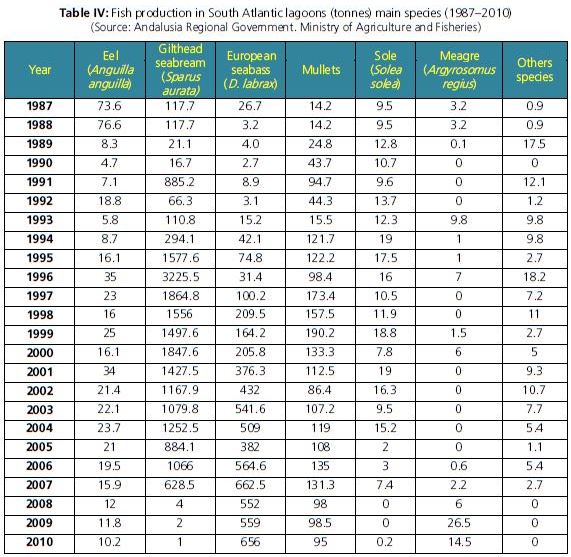
Figure 3. Fish production in South Atlantic lagoons (tonnes) main species (1987–2010). Source: Andalusia Regional Government. Ministry of Agriculture and Fisheries.
Table V: Crustacean production in South Atlantic lagoons (tonnes) main species (1987– 2010).Source: Andalusia Regional Government. Ministry of Agriculture and Fisheries. 
Figure 4. Crustacean production in South Atlantic lagoons (tonnes) main species (1987–2010). (Source: Andalusia Regional Government. Ministry of Agriculture and Fisheries)
Table VI: Mollusc production in South Atlantic lagoons (tonnes) main species (1987– 2010) (Source: Andalusia Regional Government. Ministry of Agriculture and Fisheries)
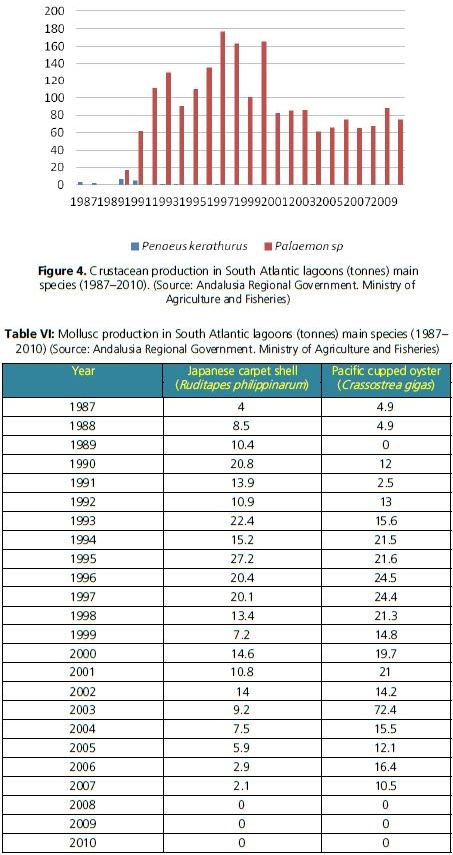
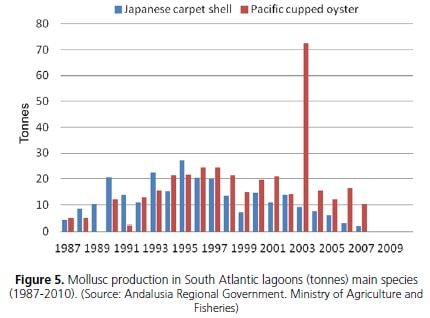
Figure 5. Mollusc production in South Atlantic lagoons (tonnes) main species
(1987-2010). (Source: Andalusia Regional Government. Ministry of Agriculture and
Fisheries)
Aquaculture production directly linked only with the South Atlantic lagoons is approximately 2 000 tonnes as annual average. This represents about 30–35 percent of aquaculture production in the Andalusia region, where these lagoons are located. Nonetheless, total aquaculture production in Spain reached 280 000 tonnes in 2010, taking into account mussel production (216 000 tonnes); therefore, without mussels, production would be approximately 60 000 tonnes (Ministerio de Agricultura, Alimentacion y Medio Ambiente, 2010).
However, if it an analysis in the Atlantic lagoons was to be made, the contribution of aquaculture production obtained is about 40 percent from the production of aquaculture in Andalusia, and therefore in regions where the lagoons are taking advantage for aquaculture activities, their contribution to the aquaculture sector is important.
Table VII: Aquaculture- Fish production in South Atlantic lagoons (tonnes) main species (1987–2010) (Source: Andalusia Regional Government. Ministry of Agriculture and Fisheries)

Figure 6. Aquaculture – Fish production in South Atlantic lagoons (tonnes) main species (1987– 2010) (Source: Andalusia Regional Government. Ministry of Agriculture and Fisheries)
Table VIII: Aquaculture – Shellfish production in South Atlantic lagoons (tonnes) main species (1987–2010)
(Source: Andalusia Regional Government. Ministry of Agriculture and Fisheries)
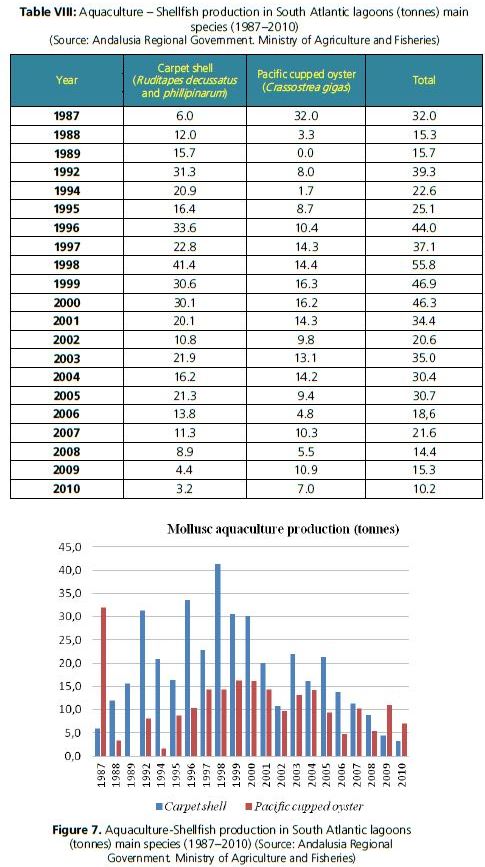
Figure 7. Aquaculture-Shellfish production in South Atlantic lagoons (tonnes) main species (1987–2010) (Source: Andalusia Regional Government. Ministry of Agriculture and Fisheries)
Table IX: Aquaculture – Crustaceans production in South Atlantic lagoons (tonnes) main species (1987–2010)
(Source: Andalusia Regional Government. Ministry of Agriculture and Fisheries)
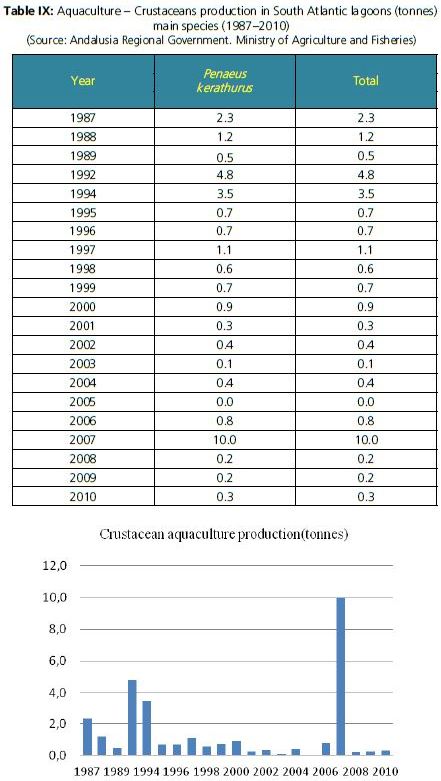
Figure 8. Aquaculture – Crustacean production in South Atlantic lagoons (tonnes) main species (1987– 2010) (Source: Andalusia Regional Government. Ministry of Agriculture and Fisheries)
As a conclusion, the contribution of catches of fish, molluscs and crustaceans from the Spanish 192
Mediterranean lagoons to national fisheries production is almost negligible (total annual production of 225 tonnes in 2010). It reflects the low degree of exploitation of aquatic resources and the scarcity of fishing in the lagoons, which in turn might be a symptom of the state of these ecosystems.
9.5.2 Other uses
The uses identified in the surroundings of the Mediterranean lagoons are usually very similar, with dominant agriculture and the presence of villages, populations, cities, transport and communication infrastructure, etc.
It should be noted that in the past years, activities related to ecological or environmental tourism have proliferated, especially bird watching, which undoubtedly contributes to increase the value of these ecosystems, and also to promote the protection of them, this being an asset of the place.